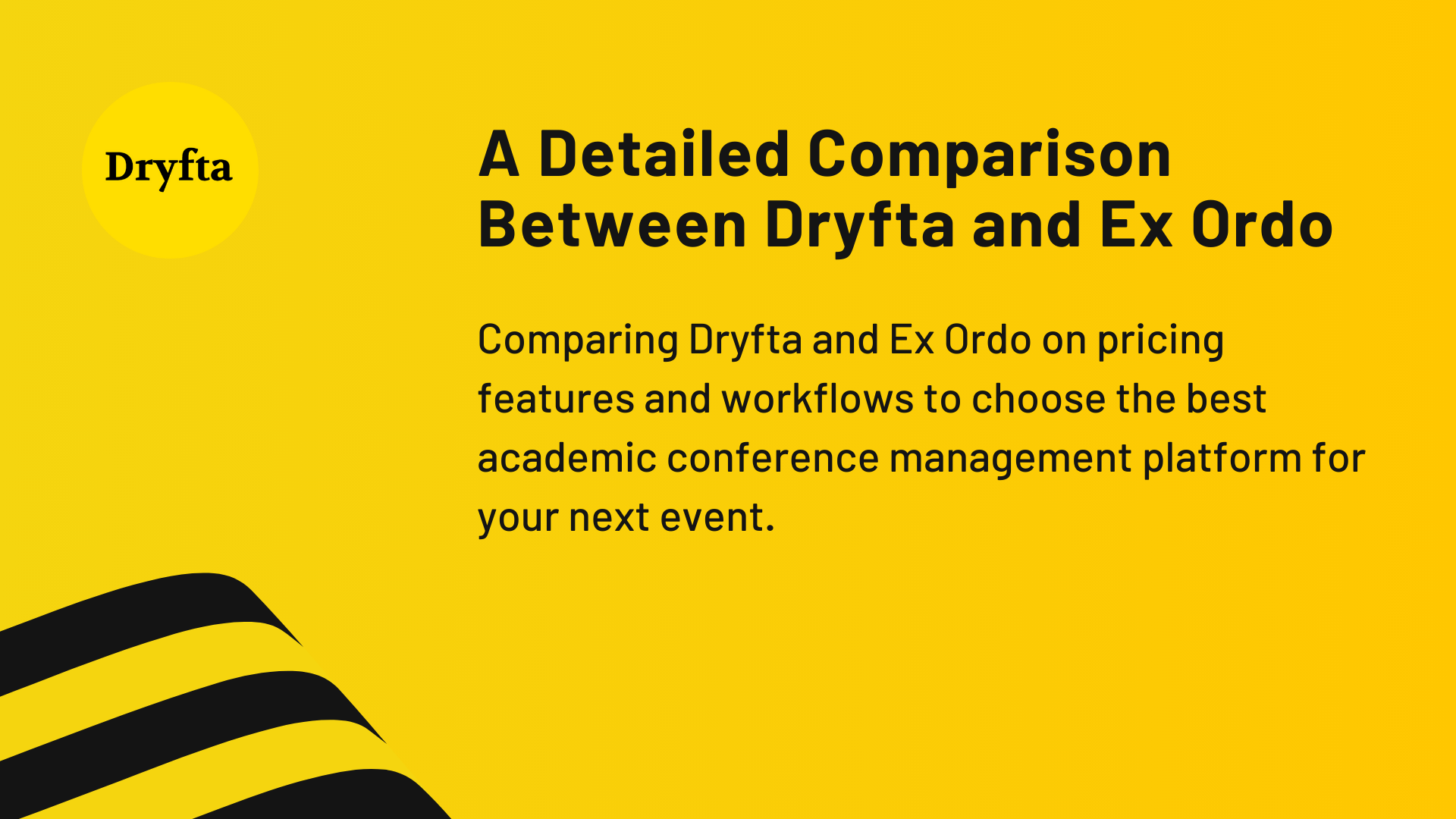
Academic event management systems are everywhere. Universities are racing to adopt them, administrators are allocating budgets and vendors are proclaiming the dawn of a new era where software handles everything from submissions to post-event analytics.
For many event organizers, after multiple unsuccessful attempts with disconnected tools, a comprehensive event management platform comes as a massive relief.
Here is everything you need to know about Dryfta and Ex Ordo, two of the most popular event management systems available in the market today.
Don’t Take the Complicated Route
The industry still hasn’t settled on a single definition of what makes an event management system truly comprehensive, and that is okay. It’s helpful to think of these platforms on a spectrum, rather than a binary.
Some tools branded as full event management solutions focus on simple automation (handling repetitive tasks like collecting submissions or processing basic registrations). Others are integrated systems, where platforms connect with payment gateways and external tools to complete multi-step processes.
Something becomes more ‘comprehensive’ as it takes on greater functionality, applies intelligent automation or integrates additional modules.
The question isn’t about which approach is objectively better. The question is rather which approach fulfills your conference needs to the fullest.
Event management platforms also provide value in several other areas:
-
- Abstract Management: Both platforms handle submission collection and organization, with reviewers stepping in for evaluation and decision-making.
- Automated Review Assignment: Systems follow structured workflows to match reviewers with appropriate submissions based on expertise.
- Registration Processing: Payment systems work together to manage attendees through the registration funnel. One collects attendee information, another processes payments through integrated gateways and yet another generates confirmation emails, automating the registration pipeline while ensuring that organizers remain in the loop for policy decisions.
How Ex Ordo and Dryfta Stand Out From Other
Ex Ordo has built a solid reputation over the years for handling abstract submissions and peer reviews effectively. The platform has served thousands of academic conferences worldwide, focusing primarily on the submission management process. It appears that the Irish company is doing well in its niche market with specialized features and a dedicated user base.
Dryfta’s comprehensive event management approach definitely matches up to the focused reputation that Ex Ordo has carefully accumulated. This platform has been building an all-in-one solution so you don’t have to juggle multiple platforms.
Ex Ordo handles submissions and reviews efficiently, providing program committees with the tools they need for peer review processes. On the other hand, Dryfta manages submissions, reviews, registrations, websites, mobile apps and post-event analytics within a single platform.
Comparatively, using Dryfta for a conference eliminates the need to integrate separate systems for registration, website hosting or attendee engagement. It is important to note that comprehensive does not mean complicated or overwhelming. Dryfta is consistently serving organizers with intuitive interfaces and state-of-the-art features that cover the entire conference lifecycle.
Abstract Submission Management
Abstract submission forms the foundation of academic conferences. This is where both platforms began, though they’ve grown differently since.
Ex Ordo’s Approach: Ex Ordo built its entire reputation on submission management. The platform provides a streamlined interface for authors to submit papers and abstracts. Drag-and-drop functionality makes file uploads intuitive. The system supports multiple submission tracks and collects detailed metadata that program committees need. Custom submission forms accommodate different paper types. The submission experience minimizes confusion, particularly for first-time conference participants who may be unfamiliar with academic submission processes.
Dryfta’s Approach: Dryfta offers flexible submission handling as one component of its broader platform. The system accommodates multiple submission types, including full papers, abstracts, posters and workshop proposals. Custom submission forms support unlimited fields. Various file formats and size requirements present no issues. Automatic plagiarism detection and similarity checking provide quality control without manual screening. The submission module integrates directly with review workflows, registration systems and program scheduling.
The Difference
Ex Ordo treats submission management as the core product, refining this functionality extensively. Dryfta treats submissions as the starting point of a longer conference journey and has therefore worked to build integration with downstream processes. For conferences where submission handling is the only concern, Ex Ordo’s focused approach delivers depth. For conferences where submissions are just one piece of a complicated puzzle, Dryfta’s integrated approach reduces friction.
Managing the Peer Review Process
Getting papers reviewed and decisions made involves significant coordination. Both platforms handle this differently.
Ex Ordo’s Review System: Ex Ordo provides sophisticated review management built on years of focusing specifically on this workflow. Reviewer assignment tools include conflict of interest checking. The system supports multiple review rounds and committees can compare reviews side-by-side, making acceptance decisions easier. The review interface emphasizes simplicity, working well for reviewers less comfortable with complex software. Ex Ordo’s strength here shows in the details. The platform understands academic review workflows deeply because this is where the company has concentrated its development efforts.
Dryfta’s Review System: Dryfta implements comprehensive review management supporting single-blind, double-blind and triple-blind review processes. Automatic reviewer assignment uses expertise matching algorithms, though manual assignment remains available. Reviewers access submissions through dedicated portals with customizable scoring rubrics and comment fields. The system tracks review progress automatically. Automated reminders go to reviewers with pending assignments, reducing administrative burden. Review data flows directly into program scheduling once acceptance decisions are made.
The Difference
Both platforms handle peer review capably. Ex Ordo’s interface is a result of years of refinement specifically for this function. Dryfta’s system emphasizes automation and integration with other conference management tasks. The practical difference appears less in core review functionality and more in how review data connects to everything else. Ex Ordo may require manual steps to move accepted papers into scheduling tools. Dryfta automatically transitions this data within the same platform.
Creating Websites Without the Headache
A conference website is the primary information center for both prospective attendees and presenters. Herein, Dryfta includes an integrated website builder that allows organizers to create professional conference websites without coding knowledge or hiring developers. The platform provides customizable templates, drag-and-drop page builders and responsive designs that function across desktop and mobile devices. The ability to manage content, update schedules and publish news directly within the event management platform eliminates the synchronization issues that plague organizers using multiple disconnected systems.
Ex Ordo offers a website creation function, though with a more limited scope compared to dedicated website builders. The platform provides basic templates and allows for customization of key pages necessary for essential conference communication. The websites function adequately for displaying basic conference information and linking to submission and registration portals.
The Difference
Organizations that are seeking highly customized websites with advanced features may find Ex Ordo’s website builder somewhat restrictive, potentially necessitating external web development resources or separate website hosting solutions that add complexity to the planning process.
Dryfta’s platform integrates with all other platform modules automatically, meaning registration forms, abstract submission portals and program schedules update in real-time without manual intervention. This live connection ensures attendees always access current information without organizers needing to update content across multiple platforms. The system also supports multiple languages, accommodating international conferences that serve diverse participant bases from different regions and countries.
Mobile Apps and Attendee Engagement
Modern conference attendees expect mobile access to event information and networking opportunities from the moment they register.
Dryfta provides native mobile applications for both iOS and Android that synchronize with the web platform in real-time. These apps deliver program schedules, speaker information, interactive maps and push notifications that keep attendees informed. The applications include networking features that allow attendees to connect with each other, schedule meetings and participate in discussion forums throughout the conference.
Ex Ordo offers a mobile app with core functionality, including schedule browsing and personal agenda management for attendees. The app provides essential features for navigating the conference program and keeping track of sessions participants want to attend. The application serves its primary purpose effectively for basic program access.
The Difference
Both platforms offer comprehensive engagement and networking features based on the industry standard. Future enhancements in this area would benefit both companies as they seek to maximize attendee interaction and satisfaction beyond simply displaying the program schedule.
Pricing Considerations
Cost considerations factor into platform selection decisions for most organizations working within budget constraints. Dryfta employs pricing models based on expected attendance and required features that scale with conference size. The platform offers different tiers accommodating small workshops to large international conferences with thousands of participants from around the world. The total cost of ownership, including the elimination of multiple separate systems for different functions, often represents a cost-effective solution for organizations managing complete conference lifecycles from start to finish without hidden integration costs.
Ex Ordo structures pricing around submission volumes and event size in a straightforward manner. The platform’s costs remain competitive for organizations primarily focused on abstract management and review processes as their main concern. Conferences requiring extensive additional features may incur costs for supplementary tools and integrations with third-party services, which should be factored into budget planning when calculating total expenses.
This is Your Sign
If you are planning an academic conference and looking to give your event management approach a complete makeover, don’t settle for fragmented solutions. Dryfta is all set to power thousands of conferences in 2026, primarily serving universities and research institutions worldwide for comprehensive event management needs. This stands as a testament to the platform’s capabilities. At Dryfta, we are committed to providing unified and intuitive solutions for organizing successful academic conferences. We’re getting advanced technology and a user-friendly design to work in unison for your needs, so you can focus on creating meaningful academic experiences rather than wrestling with multiple disconnected systems.
Both Dryfta and Ex Ordo serve the academic conference management space with dedication to their users. Ex Ordo’s strength in submission and review management makes it a good choice for organizations prioritizing these specific functions above other conference management needs. The platform serves its niche effectively and continues to develop new capabilities over time.
For academic institutions seeking a comprehensive solution that manages every aspect of conference organization within a single platform, Dryfta presents a compelling option with proven capabilities across diverse event types and sizes. The decision ultimately depends on the specific needs, technical capabilities and growth plans of each organizing body as they plan current and future academic events. However, when simplicity, comprehensiveness and attendee experience matter most, the choice becomes considerably clearer.




